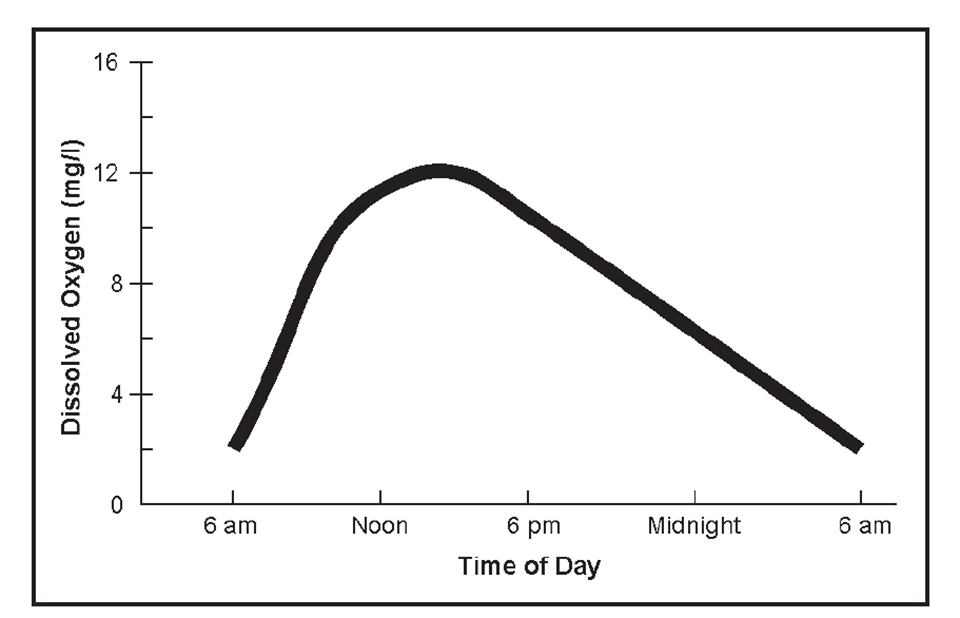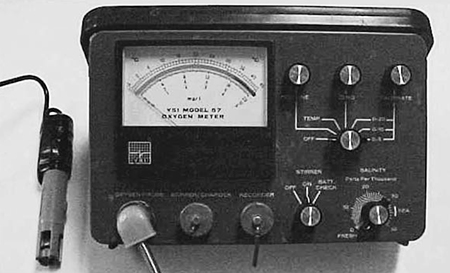Through its Responsible Aquaculture Program, GAA has recommended a range of water quality standards for shrimp farm effluents. Part of a series, this article addresses dissolved oxygen (DO).
Dissolved oxygen (DO) concentration is probably the most important single variable that influences the well-being of aquatic organisms. When DO concentrations are low, fish, shrimp, and other aquatic life suffer stress that can result in their slowed growth, susceptibility to disease, or even death. The DO requirements of warm-water fish are summarized in Table 1. Other warm-water aquatic animals respond similarly to DO.
Boyd, Common effects of DO concentration on warm-water fish, Table 1
| Dissolved Oxygen (mg/l) | Effect |
|---|
Dissolved Oxygen (mg/l) | Effect |
|---|---|
| < 0.5 | Small fish survive brief exposure. |
| 0.5-1.5 | Most species will die at exposure for a few hours or days. |
| 1.5-5.0 | Most species will survive, but stress, greater susceptibility to disease, and slow growth may occur. |
| > 5 | Desirable concentration. |
Regulations and standards
Effluent regulations focus on the prevention of low DO concentrations in receiving waters. As discussed in earlier columns, standards for total phosphorus and total ammonia nitrogen are intended to prevent eutrophication that can cause excessive phytoplankton blooms and oxygen depletion. Standards for five-day biochemical oxygen demand in effluents have been established to prevent excessive oxygen demand in outfalls. The DO concentration in effluents also is important because it can have an immediate effect on concentrations in the mixing zone of receiving waters, and consequent adverse effects on aquatic organisms.
GAA standards
In GAA’s Responsible Aquaculture Program, the standard for minimum initial oxygen concentration is set at 3 milligrams per liter, with a target value of 4 milligrams per liter. Pond water discharged in the daytime will almost always contain plenty of DO. But many shrimp ponds have DO concentrations below 3 milligrams per liter at night, and ponds usually are drained for harvest during the night. Thus, compliance with this standard requires careful attention to factors that influence nighttime DO concentration.
https://www.aquaculturealliance.org/advocate/water-quality-standards-total-suspended-solids/
DO concentrations
Oxygen makes up about 21 percent of the Earth’s atmospheric gases, and it will diffuse into water bodies until saturation is attained. As shown in Table 2, concentrations of DO at saturation decrease as temperature and salinity increase.
Boyd, Solubility of dissolved oxygen, Table 2
| Temperature (° C) | Salinity (ppt) 0 | Salinity (ppt) 5 | Salinity (ppt) 10 | Salinity (ppt) 20 | Salinity (ppt) 30 | Salinity (ppt) 35 |
|---|
Temperature (° C) | Salinity (ppt) 0 | Salinity (ppt) 5 | Salinity (ppt) 10 | Salinity (ppt) 20 | Salinity (ppt) 30 | Salinity (ppt) 35 |
|---|---|---|---|---|---|---|
| 20 | 9.08 | 8.81 | 8.56 | 8.06 | 7.60 | 7.38 |
| 25 | 8.24 | 8.01 | 7.79 | 7.36 | 6.95 | 6.75 |
| 30 | 7.54 | 7.33 | 7.14 | 6.75 | 6.39 | 6.22 |
| 35 | 6.93 | 6.75 | 6.58 | 6.24 | 5.91 | 5.61 |
Two biological processes also have a profound influence on DO concentration. Photosynthesis by green plants produces oxygen, and respiration by all organisms consumes oxygen. Biological activity in ponds can cause DO concentrations to increase or decrease so quickly that diffusion of oxygen between air and water cannot maintain saturation. Aquaculture pond waters seldom are at saturation with DO.
Daily variation
DO concentration oscillates daily. During daylight, photosynthesis in the illuminated zone usually releases oxygen faster than oxygen is used in respiration. DO concentrations thereby increase during the day to a peak in mid-afternoon. Photosynthesis stops at night, but respiration by all organisms in the pond causes DO to decline.
The lowest DO concentration usually occurs at dawn. Full sunlight strikes the pond surface, but light intensity quickly declines with depth as light is reflected and absorbed by particles in the water. Thus, DO concentrations are greater in surface water than in bottom water because there is more light to support photosynthesis near the surface.
Pond plankton and DO
Dense phytoplankton blooms in aquaculture ponds have high rates of photosynthesis. Some readers may think that ponds with dense phytoplankton blooms have a greater supply of DO than those with less phytoplankton, but this usually is not true. As phytoplankton blooms become denser, light does not penetrate as deeply into ponds and respiration rates increase.
As a result, DO concentrations in ponds with heavy plankton blooms may be very high in surface waters in the afternoon, but decline to very low concentrations at night. The daily pattern of DO concentration in a pond with a heavy plankton bloom is illustrated in Fig. 1.

Causes for low DO
The major factors that cause low DO concentration at night are dense plankton blooms and high accumulations of organic matter in sediment. The main reasons for dense plankton blooms and organic accumulation on pond bottoms are high inputs of nutrients and organic matter in feeds and fertilizers.
Preventing low DO
-

Fig. 2: Polargraphic dissolved oxygen meter and probe. Since the connection between the cable and probe tends to wear, this probe is taped for greater longevity. Management procedures for preventing low DO concentrations at night include the following:
- In ponds without mechanical aeration, maintain Secchi disk visibility above 30 to 35 cm.
- Use moderate stocking and feeding rates.
- Apply fertilizers in moderate amounts and only when needed to promote plankton blooms.
- Select and manage good-quality feeds.
- Apply adequate mechanical aeration in intensive shrimp ponds.
- Exchange water only during daytime, if possible.
- Dry out bottoms between crops and apply lime to enhance organic matter decomposition.
- Pass effluents through settling basins; retain water in basins as long as possible to encourage reaeration.
Measuring DO
The measurement of DO concentration should be done with a polarographic DO meter (Fig. 2). The meter should be calibrated each day before initiating measurements. If the sensing probe has a membrane, the membrane should always be checked for holes and to verify that an air bubble has not developed in the fluid beneath the membrane.
Meter accuracy
The accuracy of the meter should be checked occasionally. This can be done by stirring water in a bucket for 10- 15 minutes to assure saturation. Water also can be poured back and forth between two buckets 35 or 40 times to effect saturation.
The meter should provide a reading of oxygen concentration within 5 percent of the theoretical concentration for saturation (Table 2) at the temperature and salinity of the water. It also is desirable to occasionally verify that an oxygen meter reads 0 when water is depleted of DO. A spoonful of sodium sulfite can be mixed in a 300- or 400-ml container of water to remove DO. Alternatively, oxygen can be removed by boiling for a few minutes.
Probe-cable connection
The connection between the probe and cable on an oxygen meter often is a weak point. Since the probe must be shaken gently while the reading is made, stress on the connection between probe and cable can cause the wires to separate. This can be eliminated by taping the cable to the probe.
Conclusion
The importance of DO concentration cannot be overemphasized, as it is probably the most important parameter influencing aquatic organism well-being. Low DO levels are typically a problem during the night, but management procedures can be established to deal with the situation.
(Editor’s Note: This article was originally published in the December 2001 print edition of the Global Aquaculture Advocate.)
Now that you've finished reading the article ...
… we hope you’ll consider supporting our mission to document the evolution of the global aquaculture industry and share our vast network of contributors’ expansive knowledge every week.
By becoming a Global Seafood Alliance member, you’re ensuring that all of the pre-competitive work we do through member benefits, resources and events can continue. Individual membership costs just $50 a year. GSA individual and corporate members receive complimentary access to a series of GOAL virtual events beginning in April. Join now.
Not a GSA member? Join us.
Author
-

Claude E. Boyd, Ph.D.
Professor, Department of Fisheries
and Allied Aquacultures
International Center for Aquaculture and Aquatic Environments
Auburn University
Auburn, AL 36849 USA
Tagged With
Related Posts

Responsibility
Water quality standards: Total Ammonia Nitrogen
For seawater or brackish water aquaculture management, the salicylate method is best for total ammonia nitrogen analysis.

Responsibility
Appraising pond liners for shrimp culture
The use of plastic-lined ponds by shrimp farmers can significantly improve production efficiency, support more production cycles per year, and higher mechanical aeration rates and stocking densities. The capital cost of lining ponds can be very significant, so a thorough feasibility analysis is recommended when considering this production tool.

Responsibility
Management of non-hazardous solid waste in shrimp farms
Shrimp farms generate non-hazardous solid waste. Use of a sanitary trench helps comply with environmental legislation, improves biosecurity and minimizes contamination risks.

Responsibility
Effluent effects from aquaculture ponds
In general, lower-intensity pond and cage farming tends to discharge higher overall pollution loads in farm effluents than closed aquaculture systems.

